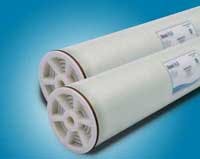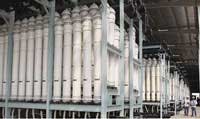How is the environmental footprint of RO membranes being reduced, through energy and biofouling improvements?
Continuing WWi magazine's series of comparing different technologies, we address reverse osmosis (RO) membranes. This article will feature recent developments in RO elements and system design, which address energy and biofouling issues, reducing cost and the environmental impact of desalination systems.
Complex Issues
Dr Graeme K Pearce, principal, Membrane Consultancy Associates
RO is often considered to be a mature membrane technology. Nevertheless, environmental drivers are leading to innovation in both membranes and process design in an effort to reduce the environmental impact of seawater desalination.
Two particular concerns have developed in the last few years. The first is the issue of energy use, which gives desalination schemes a high carbon footprint. The second is the issue of bio-fouling which increases both energy use and chemical cleaning frequency, giving a higher carbon footprint and creating a waste sludge for disposal. Furthermore, frequent cleaning reduces RO membrane life and impairs performance so that replacements are more frequent and costs are higher.
To address the issue of energy use, RO manufacturers have sought to increase permeability. However, higher water transport is of limited use if it also increases salt passage. Indeed, medium or high salinity feeds need to focus on selectivity to have the most energy efficient design. There are numerous developments of membrane elements both to improve permeability and reduce salt transport, with the optimum solution dependent on the circumstances of the particular application.
Biofouling is an even more challenging issue. It was assumed that the advent of membrane pre-treatment would eliminate this problem, but the reality is that the causes of bio-fouling are complex, and are not addressed by just having a fine particle filter.
Low fouling or bio-static surfaces are one type of approach to this problem. However, this probably has to be combined with a process design that reduces biofouling potential restricting both the micro-organisms and their food source, and creates an environment which discourages the growth of bio-films.
Improving the Energy Source
CK Kurth, vice president of membrane technology, Nano H20
The purpose of an environmental footprint is to quantify the sometimes nebulous question of how our choices affect the environment. This is commonly a literal footprint calculation, the area required to support a lifestyle. Keeping with this spirit of quantification, we can relate the benefit derived from water treatment (specifically seawater desalination by RO) to an automobile by comparing how much water can be produced with a tank of petrol.
Complete combustion of petrol releases 8.8kWh/liter of energy leaving 176kWh available with a 50 liter tank and 40% generator efficiency. It is instructive to calculate waypoints for this analysis. Fifteen years ago, seawater desalination consumed ~4 kWh/m3, or a tank of petrol could provide power to supply 40,000 liters of potable water.
The ceiling to water production is ruled by thermodynamics; with a perfect desalination technology the change in entropy limits the amount of water that can be produced to 200,000 liters. And finally, where are we now?
A tank of petrol can provide sufficient energy to produce 80,000 liters of water from a typical SWRO system. Systems often lose permeability over time due to fouling, most commonly a result of biofilms. Through various changes to surface chemistry and module construction, researchers are attempting to minimize this deposition. If successful, such antifouling modules would prevent increased feed pressures needed to maintain output. More specifically, an additional 6,000 liters of water could be produced if bio-fouling is eliminated from a system that had been losing permeability at a rate of 5% per year.
Very recently, improved SWRO modules were introduced with twice the permeability of conventional units allowing operation at lower pressures. Converted to tank equivalents, these membranes allow production of an additional 20,000 liters of water.
However, there is a point of diminishing returns with permeability. The portion of energy used to transport water through the membrane eventually reaches zero, while other portions remain unchanged. For example, development of a membrane one thousand-fold more permeable than those currently available would only give an additional 20,000 liters of water per tank.
Some of the largest remaining energy savings come from a focus on the source of energy. Increasing the generator efficiency from 40% to 47.5% would give the same benefit as the 1000x increase in permeability. System level developments allowing operation at varying power input would enable direct application of renewable energy sources and significantly shift the carbon footprint required for operation.
Company Developments
By leveraging the benefits of nanotechnology, NanoH2O's QuantumFlux® thin-film nanocomposite (TFN) RO membranes have demonstrated a 50-100% increase in permeability over traditional membranes, while delivering best-in-class salt rejection. Enhance permeability of QuantumFlux membranes can translate to an increase in the amount of fresh water produced, given a certain pressure, over typical thin-film composite membranes. The use of QuantumFlux membranes to produce a set amount of water can lead to a reduction in the number of elements employed. In addition, NanoH2O's line of high rejection membranes can reduce a system's second pass while still meeting stringent water quality standards. Both scenarios present a unique opportunity to reduce a desalination plant's physical footprint, thus lowering capital expenditures for a new project.
Importance of Feed Space Configuration
Katariina Majamaa, global application development leader IWT, Dow Water & Process Solutions
For industrial plants today, conserving energy and reducing biofouling to improve operational performance are primary goals as they look to make high quality goods with water as an important utility. Operating manufacturing sites requires a reliable water utility that matches the specifications needed for efficient production.
Until recently, having a low energy RO membrane with a highest achievable salt rejection and/or fouling resistance was only a dream. Today, a breakthrough in reverse osmosis membrane chemistry has delivered a novel brackish water reverse osmosis (BWRO) membrane, delivering end users state-of-the-art salt rejection (99.7%) at 30% lower energy consumption compared to current high rejection BWRO membranes in addition to tailored salt passage reduction of critical solutes as nitrate, boron, silica, and ammonium.
The improved energy efficiency of thin film composite membranes is a direct result of the improved membrane permeability that allows for less energy to produce more water. Plant engineers and manufacturers no longer have to choose high-rejection over energy efficiency. The surface chemistry of an active membrane can be modified such that it becomes fouling resistant, that is, more resistant to the adsorption and accumulation of foulants. This is recognized as one of the best options to tackle biofouling.
The latest innovations have also brought the fouling resistance character to the low energy membrane range, resulting in operation with 30% less energy than typical fouling resistant membranes.
Moving beyond membrane selection, RO element construction, more specifically feed spacer configuration, can be varied to reduce energy consumption as well as to reduce fouling and the effect of fouling upon system performance. The feed spacer has a critical role in biofouling development and the spacer configuration can be optimized for high fouling potential or challenging feed conditions.
One configurable parameter is the feed spacer thickness. It is often considered that a thicker feed spacer will mitigate fouling and provide a reduction in pressure drop across the element resulting in a reduction in energy usage. Another impact area on both energy and fouling reduction is to modify feed spacer configuration to reduce the resistance to water flow. The novel module components, low differential pressure (LDP) feed spacers, provide end users with up to 15% savings in direct RO energy reductions via the lowest feed-side pressure drops available in the market.
These advantages of thin film composite membranes enable the reduction of the environmental footprint of RO membranes by improving their energy efficiency, reducing their fouling rate and reducing chemical consumption in downstream processes.
Company Developments
To address the challenge of supplying RO elements that reduce energy costs and biofouling, Dow Water & Process Solutions has developed the DOW FILMTEC™ ECO membrane – the first product in the new portfolio designed to be more sustainable, higher-efficiency membranes.
Dow experts found that there was diminished energy savings in membrane innovation alone, but through specific configuration for energy and element design there could be further energy savings realized. With a performance of 99.7% rejection at 150 psi, the elements enable robust performance.
At highest quality, DOW FILMTEC ECO elements deliver 40% lower salt passage at 30% less energy when compared to standard RO elements, resulting in an ecologic and economic win.
The Importance of Pre-treatment
Willy Yeo Wei Ning, vice president, membranes marketing and business development, Hyflux
RO technology has improved tremendously since its first commercialised use in the 60s and 70s. Today, it is one of the most widely used water purification processes in the world. Despite the advantages that RO brings, it is still an energy intensive process, giving rise to its high environmental footprint. One key step in reducing the environmental footprint of RO membranes is a robust membrane-based pre-treatment system, which brings about less frequent fouling and higher fluxes in RO operations, resulting in a smaller RO footprint and less energy needed per m3 of freshwater produced.
Compared to other methods of pre-treatment, Ultrafiltration (UF) membrane pre-treatment technology provides an excellent barrier to particles and microbes due to its small pore size and sharp rejection profile, thereby reducing the incidence of fouling. This is because UF membranes produce consistently high quality permeate regardless of fluctuations in feed water.
By acting as an effective barrier to suspended solids and microorganisms, UF membranes reduces the presence of foulants which may give rise to particle, colloidal and biological fouling on the RO membrane surface.
With reduced fouling, it reduces the blockages on the RO membranes surface and hence allows RO membranes to be operated at up to 20% higher flux. The increase in overall efficiency allows the RO membranes to be able to produce the same capacity of permeate at lower pressure, thus leading to less energy consumption and fewer RO membranes needed, hence reducing its footprint.
In addition, the use of UF membrane pre-treatment technology results in material cost savings. Lower chemical dosing for UF pre-treatment and less frequent RO cleaning due to the high quality feed water from the UF, reduces chemical costs as well as the amount of chemicals being discharged into our environment. With a lower incidence of fouling, the lifespan of the RO membranes can be extended, thereby reducing RO replacement costs and carbon footprint.
Company Developments
The recent introduction of Kristal 600ET3 bolsters Hyflux's polymeric membrane offering to support the wide-ranging needs of the RO industry. Made from modified polyethersulfone (PES), Kristal 600ET3 is a polymeric ultrafiltration membrane with three channels per fibre (tri-bore), thereby having enhanced fibre strength and permeability as well as faster permeate flow. Certified to the NSF Standard 61, Kristal 600ET3 delivers superior permeate quality and has been proven to effectively remove the drinking water contaminant cryptosporidium and achieve a 4-log reduction of giardia. Its effectiveness in rejecting suspended solids and microorganisms is manifested in consistently low permeate turbidity, silt density index and total bacterial/viral counts, despite fluctuating feedwater quality.
Biofiltration to Control Biofouling
Dr. Boris Liberman, CTO membrane technology, IDE Technologies
Reverse Osmosis desalination technology has developed and matured to the point that it is widely recognized as a sustainable solution for the worldwide scarcity of water. Led by an ever-increasing awareness of the need for environmental preservation, it has become critically important to select technologies designed to minimise adverse effects on the environment and achieve a favorable overall environmental profile.
Energy consumption can be reduced in various ways including, but not limited to, innovative design approaches coupled with state-of-the-art technologies, optimization of recovery yield of the RO system, and highly efficient motors, pumps and energy recovery devices. Another way to reduce energy consumption is to maximise the benefits of variable production rates. By doing this, it takes advantage of lower electricity rates for high production and reducing production during the times that the electricity cost is highest. This type of variable production requires a design that is able to support it.
Biofouling is one of the critical issues in membrane water treatment as it has a significantly detrimental effect on the efficiency of the treatment processes. Conventional pre-treatment methods incorporate the use of coagulation and flocculation agents and other chemicals in an attempt to control this phenomenon. The adverse effects of the use of chemicals have gained attention over recent years, from the need to produce, transport, handle and store chemicals, with the inherent risks of spills and exposure, through to the need to safely dispose of spent chemicals.
This has led to the investment of significant economic resources in the development of effective strategies for controlling and addressing biofouling. Among these the efficacy of biofiltration has been examined and has been found to be a viable method for the removal of assimilable organic carbon, as well as dissolved organic carbon. Biofiltration was also found to reduce the rate of biofouling.
In addition to effective pre-treatment, normal operation of a plant requires periodic cleaning of the membranes when they become fouled.
As the fouling compounds are many and diverse, numerous chemicals are required for effective cleaning. Alternate methods of cleaning, without the use of chemicals or need to stop the plant are being investigated. Cleaning methods are often combined in order to achieve effective membrane cleaning.
Company Developments
• How is IDE Technologies addressing these challenges?
Pressure center design allows diminished power consumption, and maximizing the benefits of variable production rates during the day since it allows increasing/decreasing the feed pressure to the RO trains; during decrease in production, all RO trains are kept in operation and the system recovery is decreased without increasing the total feed to the plant.
Bio-Flocculation and Bio-Filtration pre-treatment – In contrast to conventional chemical pretreatment methods, IDE achieves a comparable or superior result without the use of any chemicals or other external inputs, thereby eliminating the need for safe disposal of spent chemicals in the filters' backwash stream.
Optimized configuration of the RO membrane banks – implementation of 16" membrane elements installed in vertical pressure vessels – resulting in identical salt rejection performance as 8" membranes and a correspondingly 4.3 times larger flow rate at the same feed pressure and operation conditions.
Patented Direct Osmosis Cleaning – allows cleaning of RO membranes without use ofchemicals and without interrupting plant operation.










